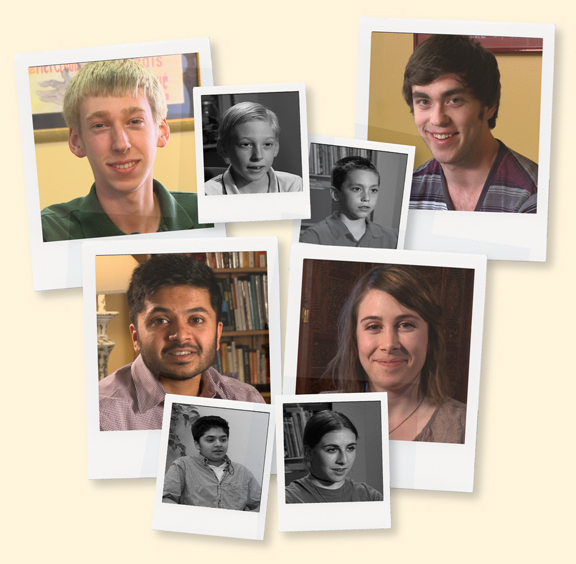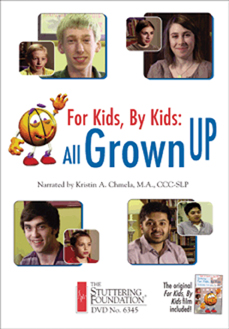
It has been 11 years since Stuttering: For Kids, By Kids. Here’s an update on four of the kids featured in the video.
By Nancy Ribbler, M.A., CCC-SLP, BCS-F
It has been a decade since I first watched the original video, Stuttering: For Kids, By Kids. I have been using this video in therapy on a regular basis with my school-age clients. Now, 11 years later, I have just watched the sequel — For Kids, By Kids: All Grown Up, showcasing four of the children featured in the original video.
As I watched All Grown Up, I was touched by the honesty and wisdom shared by Naomi, Daniel, Tommy and Umang. They spoke about their experiences with speech therapy, parent involvement, dealing with attitude changes and the challenges that go along with being a person who stutters.
I loved learning about their journeys from childhood to adulthood and even needed a tissue at the end to dry my tears. But I wondered ... could this follow-up video help my clients deal with some of their own challenges?
I decided to find out and asked some of my clients to be DVD reviewers. I created a video critique form and used it as a therapy activity with my 4th and 5th grade students, as well as two of my private clients—a 15 year-old teen and an adult client.
I asked them to watch the video and give me their honest feedback. How did they connect to the “common threads” discussed by the four individuals; what was their overall impression; and would they recommend this DVD to others who stutter?
My 4th and 5th graders were very familiar with the original DVD, For Kids, By Kids. They were excited to see how the kids looked eleven years later and interested in what they had to say as “grown-ups.”
 A fifth grade student who stutters commented, “now that they’re older, speech is easier for them.” He mentioned that he connected with both Naomi and Daniel when they spoke about parent involvement. He said that he related to both because he likes having his dad involved in therapy like Daniel; however, like Naomi, he doesn't like certain aspects of parent involvement with his stuttering.
A fifth grade student who stutters commented, “now that they’re older, speech is easier for them.” He mentioned that he connected with both Naomi and Daniel when they spoke about parent involvement. He said that he related to both because he likes having his dad involved in therapy like Daniel; however, like Naomi, he doesn't like certain aspects of parent involvement with his stuttering. He shared that his dad has given him advice about how to stop his stuttering, and it is very frustrating. This was a revelation for him that was uncovered thanks to this video.
Another positive outcome involved the discussion in the video about accepting help from others. One student followed up with Naomi’s comments about teacher involvement. He shared that a teacher once asked him why he talked the way he did. He remarked that it is the responsibility of a student who stutters to “let his teacher know about stuttering.”
My 15-year-old client is usually reserved when it comes to cognitive-emotional issues. However, after watching this video, he shared some insights. He expressed nervousness about reading aloud, like Naomi.
He related to Daniel about changing his attitudes and shared that he’s more open about his stuttering now. He also connected to Tommy’s story about his parents refusing to order food for him in a restaurant. He admitted that he used to have his parents order for him, but now has the courage to order for himself.
And lastly, he shared his dream of becoming a lawyer like Umang. He had not revealed this before. He rated the video “9 out of 10” and felt that it was “pretty inspiring.”
The last client asked to review the DVD was an adult who stutters. She watched the original video, For Kids, By Kids first and then All Grown Up. The original video, For Kids, By Kids, is included with All Grown Up, which made it convenient to show both with just a click.
From an adult perspective, she shared that she appreciated seeing what the kids went through and related to some of the high school challenges, such as being uncomfortable going to therapy as a teen. She also related to the aspect of being open with stuttering, as Daniel mentioned, and shared how she is starting to be more open with her stuttering with some co-workers.
I found this video to be a door-opener for discussions with my clients about their feelings and emotions. It seemed easier and “safer” for them to discuss the sensitive topics such as parent/teacher involvement in therapy, changing attitudes, dealing with challenges and future goals in the context of reviewing the stories of Daniel, Tommy, Naomi and Umang. It worked well in therapy to use the video as a three-step process:
• First, getting feedback in writing using a “video critique form”;
• Second, discussing their impressions/insights about the stories shared in the video; and
• Finally, sharing their own feelings and connections with the topics and stories discussed in the video.
For Kids, By Kids: All Grown Up is a 20-minute film produced and narrated by Kristin A. Chmela, M.A., CCC-SLP, and Bob O’Brien, Video Design Productions.
From the Winter 2015 Newsletter






 Podcast
Podcast Sign Up
Sign Up Virtual Learning
Virtual Learning Online CEUs
Online CEUs Streaming Video Library
Streaming Video Library